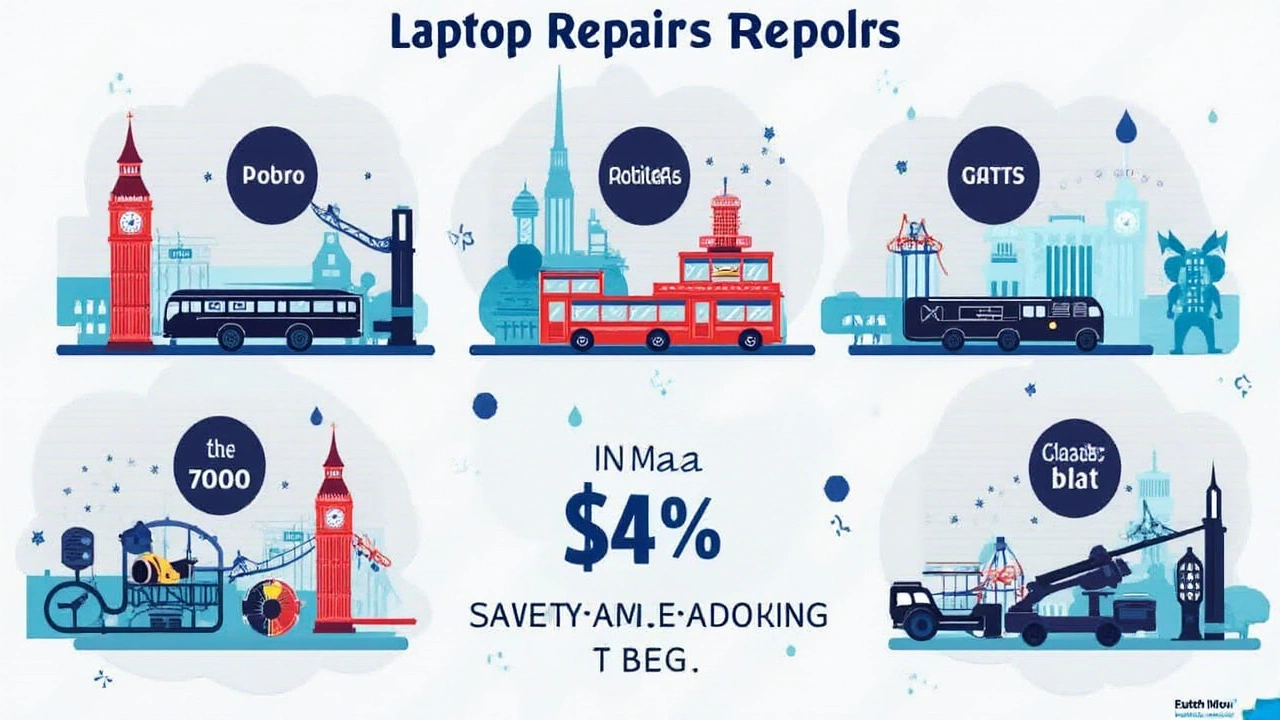Ever wondered why fixing your laptop costs so much? You're not alone. A lot goes on behind the scenes that many folks might overlook. From the intricate design of modern machines to the skilled labor required, there's more to it than meets the eye.
First off, today’s laptops are like little technological marvels. They're sleek, fast, and packed with features. While that's awesome for performance, it makes them trickier to fix. More complex technology means repairs require specialized skills and tools, which ups the price.
Then there are the parts themselves. Genuine components, especially for popular brands, can be pretty pricey. So, when you need a replacement piece, it’s not just the labor you're paying for, it’s the cost of the original or high-quality third-party parts too.
- Complexity of Modern Laptops
- Pricey Components
- Labor Costs
- Warranty and Insurance
- DIY and Preventive Tips
Complexity of Modern Laptops
So, we all adore our shiny, sleek laptops, right? But here's the thing: their fancy designs make them a puzzle when it comes to repairs. Today’s laptops are packed with technology, like high-res screens and touchpads, which add layers of complexity. It's like trying to fix a tiny spaceship!
Many modern laptops come with ultra-thin bodies and everything crammed inside, leaving not much room for error during repairs. Touchscreen models? They’re even more complex with layers of glass and digital components all tightly packed. A Forbes article once noted,
“As computers become more advanced, the intricacy of their construction means repair requires not only skill but precision.”
Think about Apple's MacBook and their famous retina displays—they are a dream to use but can be a nightmare to repair. You can't just pop it open with a screwdriver. This need for specialized toolkits and skill adds to the repair costs.
Why Worse Than Older Machines?
Maybe you've noticed older laptops seemed easier to take apart? That’s not just nostalgia. Older models often used screws which meant easier to disassemble. In contrast, newer ones may use glue or soldered parts that make even simple repairs tough.
Also, integrated components are more common now. Stuff like jam-packed graphics and CPUs might mean you have to replace a whole board when just one part fails. This adds up cost-wise and it explains why laptop repair isn't as straightforward as it used to be.
How Does This Affect Repair Shops?
Repair shops face these challenges, too. They have to keep up with the high pace of tech advancement and be jacks-of-all-trades for various brands and component structures. This expertise naturally costs more.
No surprise here—laptop repair is expensive because of the tight design and complexity in modern machines. So, next time you're debating a fix, remember you're dealing with a miniature masterpiece of tech that just needs some extra loving care.
Pricey Components
One of the major culprits in the high cost of laptop repair is the price of components. Let's face it, laptops have come a long way in terms of features and performance, but so has the complexity of their parts.
Take screens, for example. High-resolution displays, touch-sensitive screens, and anti-glare technology make for a beautiful viewing experience but also result in steeper repair costs. Think about it—everything from the glass to the tiny pixels underneath must be perfectly aligned and are often customized for specific laptop models.
Then there's the motherboard, often viewed as the heart of your laptop. A motherboard replacement can be one of the priciest repairs, sometimes costing upwards of a few hundred dollars. Here's a tidbit—if your motherboard goes kaput and your laptop's over a few years old, replacing the entire laptop might cost just a little more than fixing it.
According to a report from TechInsights, "the average cost of key laptop components like CPUs and GPUs has seen a 15-20% increase over the past decade."
"The intricacy and customization of each part tailor-made for a specific laptop brand make the components expensive," says David Nguyen, a senior tech analyst at TechRadar.
Another factor is the use of brand-specific parts. Many manufacturers use proprietary technology that doesn't work well with third-party substitutes, pushing up costs. This brings us to batteries—non-removable, specialized batteries fit your laptop like a glove but can drain your wallet during replacement.
Be Smart About Parts
Here's a tip. Always ask if refurbished parts are an option when getting a quote for laptop repairs. They're often cheaper and perform just as well, especially if they come from a trusted supplier or through the repair service itself.
So, while the magic of technology makes our laptops fun and efficient, keep in mind the trade-off might be some extra dollars when something breaks.

Labor Costs
Now, let's chat about the labor costs involved in laptop repair. You might think it’s just about tightening a few screws here and there, but it’s a bit more involved than that. The real challenge lies in the expertise and precision needed to handle these complex devices.
Technicians need specialized training to understand the intricacies of different laptop models, especially the popular ones we use daily. Training isn't cheap or quick—it demands time, certification, and constant updates with the latest tech trends. This isn't something you pick up in a weekend crash course. You’re essentially paying for their years of experience and the reassurance that they know what they're doing.
According to James Anderson, a certified electronic technician, "The art of laptop repair is not just about fixing what’s broken. It’s understanding how each piece fits into the bigger puzzle, ensuring longevity and optimal performance post-repair."
Considering the time and skill needed, labor prices can vary widely, especially if you're relying on an official service center versus a local repair shop. While brand centers often ensure high-quality repair with genuine parts, they typically charge more for maintaining authorized service standards. Small local shops might offer cheaper rates, but sometimes at the risk of using non-original components or less specialized skills.
So next time you wonder why laptop repair costs the way it does, remember, it’s not just about swapping out a part—it’s about ensuring your device runs as smoothly as it did out of the box.
Warranty and Insurance
When it comes to laptop repair costs, understanding your warranty and insurance options can be a game-changer. Most new laptops come with at least a one-year manufacturer's warranty. This can save you from hefty repair bills on certain issues like faulty hardware. But here's the catch: warranties don’t cover accidents, spills, or mishandling. That’s where insurance comes in.
Warranties are awesome for defects that aren't your fault. If your internal components are acting up out of the blue, you might be covered for repairs or even a replacement. Always check the details; not all repairs are on the house.
Insurance Options
Laptop insurance might seem like overkill, but it's worth considering, especially if you’re accident-prone or travel often with your device. Insurance usually extends beyond what a warranty does. We're talking about coverage for theft, drops, spills, and other mishaps.
- Read the fine print: Not all policies are the same. Coverage limits, deductibles, and exclusions differ.
- Compare options: From manufacturers' plans to third-party options, shop around for the best deal.
- Consider lifestyle: Heavy travelers and remote workers might need broader coverage.
Some companies offer bundled tech insurance plans, where you can cover multiple devices under one policy. This might save some cash if you’re already paying for separate insurance for your smartphone or tablet.
Speaking of numbers, a study showed that around 10% of laptop users experience some form of accidental damage every year. A crucial stat if you're debating the value of insurance!
Understanding your laptop's warranty and exploring insurance options can offer peace of mind and potential savings on those expensive repairs. It's about being prepared and making savvy choices for potential future hiccups.

DIY and Preventive Tips
If you're looking to save a few bucks on laptop repair, there are some things you can tackle on your own, and steps you can take to keep that device in tip-top shape. Before you dive into fixing it yourself, remember that DIY isn't for everyone. But if you're game, here's what you need to know.
Regular Maintenance
- Keep it Clean: Dust can be a laptop's worst enemy. Regularly cleaning your keyboard, screen, and vents helps keep components cool and functioning.
- Software Updates: Staying on top of software updates is crucial. These often include security patches and performance improvements that could prevent problems down the line.
- Battery Care: Avoid full discharges and keep an eye on your laptop's battery health. When it drops below 20%, plug it in to ensure longevity.
Simple Fixes You Can Do
Fixing some laptop issues doesn't always need a pro. Here are a couple you can try:
- Upgrading RAM: If your device is slow, adding more RAM is a fairly straightforward process with a world of difference. Check your model compatibility and how-to guides online.
- Replacing a Hard Drive: A failing hard drive can often be swapped for an SSD, boosting speed and performance. Follow step-by-step videos from reliable sources.
Preventive Actions
Prevention is key to avoiding expensive repairs:
- Use a Cooling Pad: Overheating is a common issue that can lead to hardware damage. A cooling pad keeps your laptop's temperature under control during heavy use.
- Backup Regularly: Frequent data backups to cloud storage or an external drive can save your precious files if your hard drive bites the dust.
While DIY can save money, don't hesitate to call a professional for complex repairs. Remember, some things are best left to those with the right skills and tools to avoid further damage.


